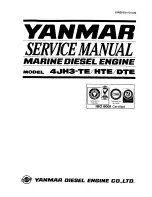
5.14
Section 5
Fuel System and Governor
2. The stepper motor, electronic control unit
(ECU) and oxygen sensor can all be checked with
the Kohler Emission Sentry
™
Tester (Kohler Part
No. 12 761 07-S).
a. Separate the plug connector between the
electronic control unit (ECU) and the stepper
motor. Plug the separated connectors into
the mating connectors on the Emission
Sentry
™
Tester. Connect the single black lead
to battery negative or a good ground on the
engine/unit. Turn the key switch on the dash
to the ‘‘run’’ position, and push the small
toggle switch on the tester to the ‘‘open’’
position. Observe the red LED’s for the ECU
and the bicolor LED’s for the stepper motor.
The red LED’s should flash in sequence, the
bicolor LED’s should alternate colors, and
you should hear the stepper motor turning.
Now push the toggle switch to the ‘‘close’’
position and repeat your observations. The
red LED’s should flash in the reverse
sequence, the bicolor LED’s should again
alternate, and you should again hear the
stepper motor turning. If any or all of the red
LED’s are not flashing, the ECU is faulty. If
the bicolor LED’s are not alternating and/or
the stepper motor is not running, the stepper
motor is faulty.
b. Allow the toggle switch on the tester to return
to the ‘‘monitor’’ position, start the engine,
and place the throttle between midrange and
fast. Observe the LED’s on the tester. The
red and bicolor LED’s should flash as in the
previous test. The green LED (oxygen
sensor) will be off initially, unless the muffler
is still hot from prior running. As the oxygen
sensor reaches operating temperature, the
green LED should begin to flash on and off. If
it stays on or off, or the interval between
flashes is more than 25-30 seconds, the
oxygen sensor could be faulty or the load
adjusting screw in the fuel metering valve
may be stuck or binding. Proceed to step 3.
3. Remove the stepper motor/fuel metering valve
assembly from the engine. Remove the four small
socket head screws and separate the fuel
metering valve from the stepper motor. Try to turn
the load adjusting screw with the blade of a small
screwdriver (see inset in Figure 5-17). If the screw
turns freely and easily, the oxygen sensor was
faulty (step 2b).
If the screw is stuck or binding, remove it from the
valve body, clean the threads with solvent, and
reinstall. Check it again for binding. Do not use
any type of lubricant on the threads of the load
adjusting screw.
NOTE: If the oxygen sensor is removed from the
exhaust manifold for any reason, a high
temperature anti-seize compound
(Loctite
®
No. 767) should be applied to
the threads. A new replacement sensor
already has a dry anti-seize compound
on the threads; additional compound is
not required.
4. If the fault circuit triggers while the engine is
idling, but not during normal operation, the idle
mixture screw on the regulator is probably out of
adjustment. Turn the screw 1/2 turn clockwise,
start the engine, and run it at idle for
approximately two minutes. If the fault circuit does
not trigger, the problem has been corrected. If the
fault circuit is triggered and the engine shuts off
before two minutes, turn the screw an additional
1/4 turn clockwise and test again for two minutes.
Governor
These engines are equipped with a centrifugal
flyweight mechanical governor. It is designed to hold
the engine speed nearly constant under changing load
conditions. The governor gear/flyweight mechanism is
mounted inside the crankcase and is driven off the
gear on the balance shaft.
Operation
As the governor gear rotates, centrifugal force causes
the flyweights to move outward as speed increases. As
the flyweights move outward, they cause the regulating
pin to move outward.
The regulating pin contacts the tab on the cross shaft,
causing the shaft to rotate when the engine speed
changes. One end of the cross shaft protrudes through
the side of the crankcase. Through external linkage
attached to the cross shaft, the rotating action is
transmitted to the throttle lever of the carburetor.
Содержание COMMAND CV11
Страница 1: ...1 COMMAND SERVICE MANUAL VERTICAL CRANKSHAFT CV11 16 CV460 465 CV490 495...
Страница 20: ...2 4 Section 2 Special Tools...
Страница 28: ...4 4 Section 4 Air Cleaner and Air Intake System...
Страница 54: ...6 6 Section 6 Lubrication System...
Страница 109: ...9 15 Section 9 Disassembly 9 Regulating Pin Governor Gear Figure 9 53 Removing Governor Gear...
Страница 110: ...9 16 Section 9 Disassembly...
Страница 146: ...1 COMMAND SERVICE MANUAL VERTICAL CRANKSHAFT CV11 16 CV460 465 CV490 495...
Страница 148: ......
















































